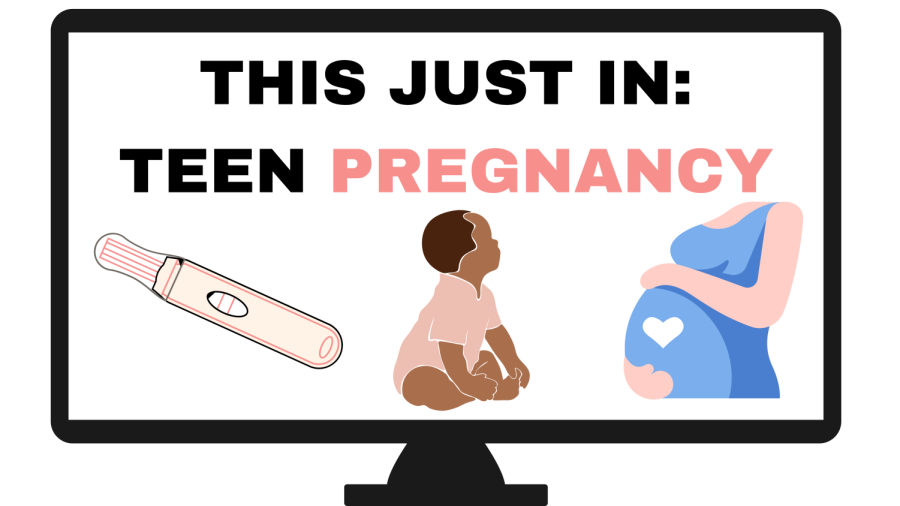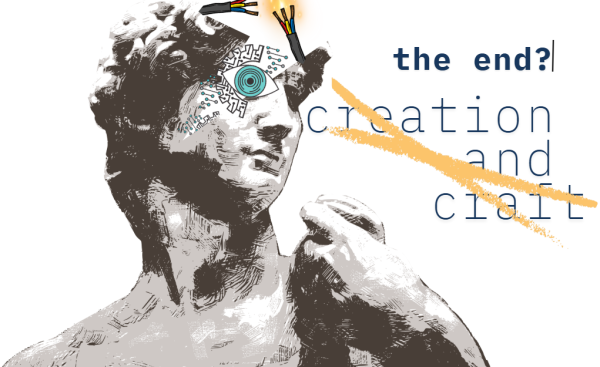Teen Pregnancy: Myths in the Media
Photo by Savana Moore
The title “This Just In: Teen Pregnancy” displays on a TV screen along with graphics about pregnancy.
Jan 30, 2023
When it comes to teen pregnancy, there are a lot of misconceptions that many people share. Many believe that the rate of teenage pregnancies has been increasing over the past couple of decades. This, however, is not the case. They have actually been declining since 1991 according to the CDC. What led people to believe this?
In the late 2000s, MTV graced our screens with “16 and Pregnant,” a reality show following the lives and pregnancies of six young girls. The show was a hit, with the first season’s finale gaining a record-breaking view count of 3.4 million. Of course, this was a reality show, so a lot of the events were forced or unrealistic. It still gave many people misconceptions about the reality of teen pregnancy.
The movie “Juno” came out in 2007, starring Elliot Page and Micael Cera. This movie followed the main character, Juno, who gets pregnant in high school. She wants to have an abortion but is convinced by a protestor to give it up for adoption instead. Juno decides to give her baby away to a married couple, played by Jason Bateman and Jennifer Garner. The movie was a big hit and was a prime catalyst in creating a new culture surrounding teen pregnancy.
The stigma around teenage pregnancy has greatly changed over the past 100 years. In the early 1900s, if you got pregnant young and out of wedlock, the norm was to keep it under wraps and get married to the father as soon as possible. As time has gone on and medicine has developed, more options are available to young mothers. There are more ways to prevent it, but if it does inevitably happen, you’re not necessarily “stuck.” It is no longer the social norm that you are obligated to get married, and you don’t have to keep the baby either. People are, for the most part, generally more accepting of teen moms these days. Whereas in the past people have been a lot more critical towards teen moms. A big contributor to this shift has been the shift in media portrayal.
One of the darker but, in some cases, more realistic approaches to portraying teen pregnancy in a movie is “Precious.” “Precious” is a 2009 film based on the 1996 novel “Push.” The movie follows our main character, Precious, who cannot read or write, in her tough journey through abuse and pregnancy. It’s difficult to do this movie justice with just a short recap, but the short of it is that Precious’ father rapes her, and she ends up pregnant for the second time at his hands. Her mother is very vicious towards Precious all throughout the movie. Precious sees a chance to turn her life around when she is offered an opportunity to transfer to an alternative school. Precious meets her new teacher, Ms. Rain, who gives her the education and guidance she needs to escape oppression and be on the road to self-determination. This movie was revolutionary in the way it portrayed teen pregnancy.
Another situation that contributed to the change in media portrayal was the “Gloucester 18.” At a high school in Gloucester, Massachusetts there were 18 reported cases of pregnancy in one school year. Due to an incorrect statement from the school’s principal, the media believed that there was a pregnancy pact between the girls and that they did whatever they could to get pregnant. As expected, many news stations across the country picked up this story and ran with it. Movies and TV shows were made. This inaccurate representation of the situation only further aided in the misconceptions of not only the number of teen pregnancies but also the weight of many girls’ circumstances.
While it is easy to believe the media’s account of a lot of topics, it is very important to do your own research before you have any prejudices, whether good or bad, especially with such a sensitive topic that touches so many people.































